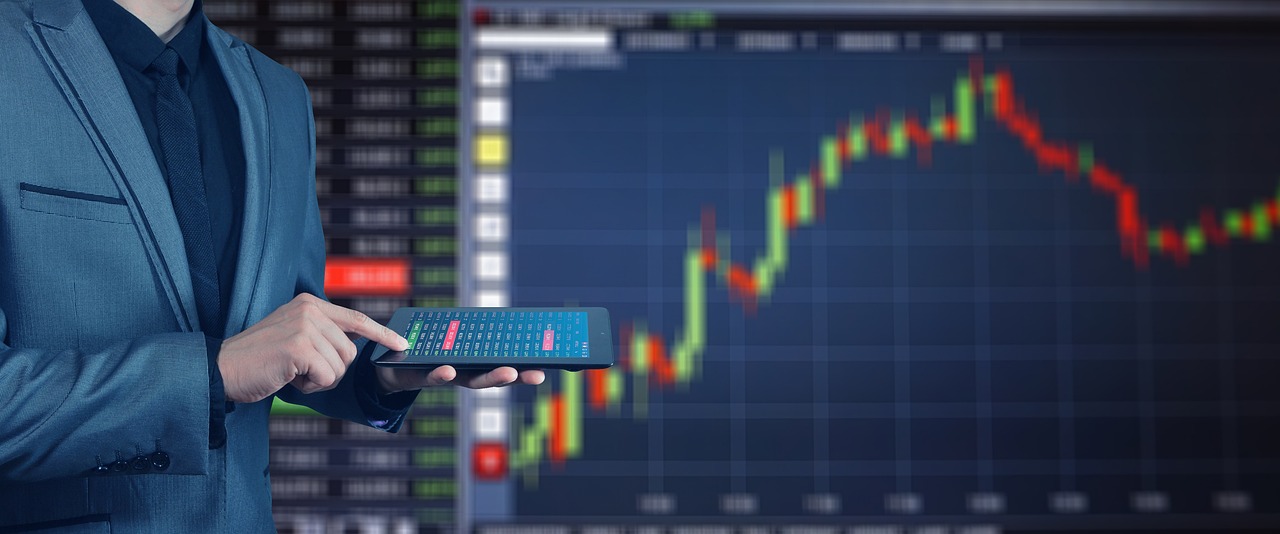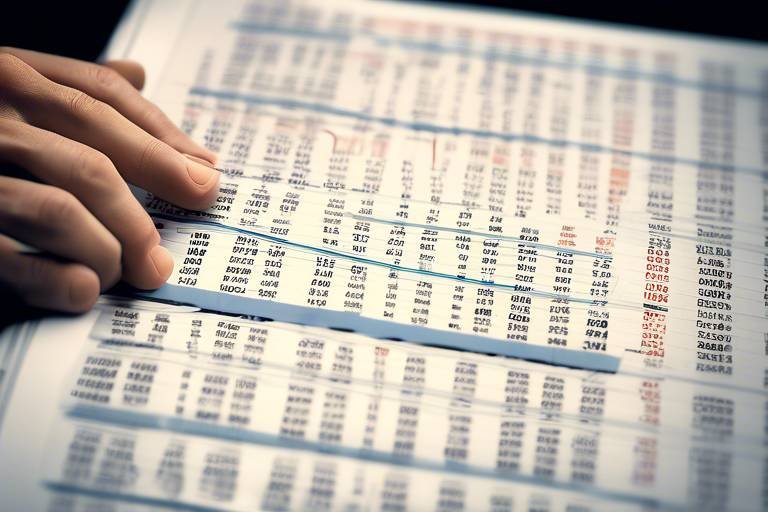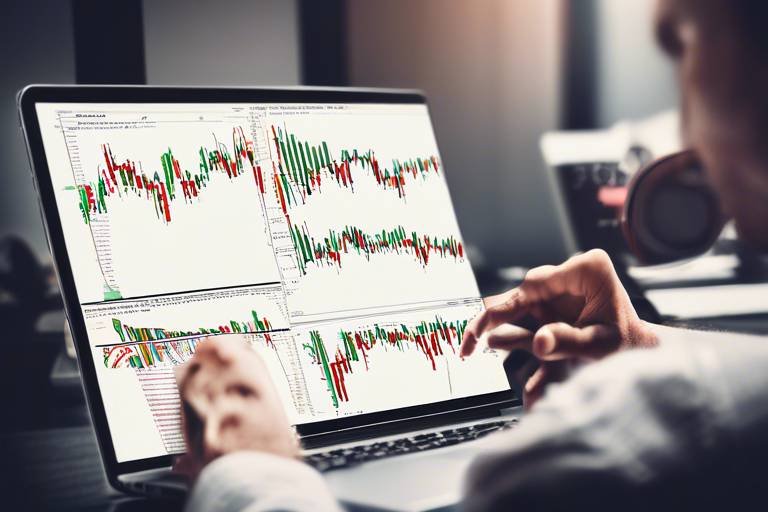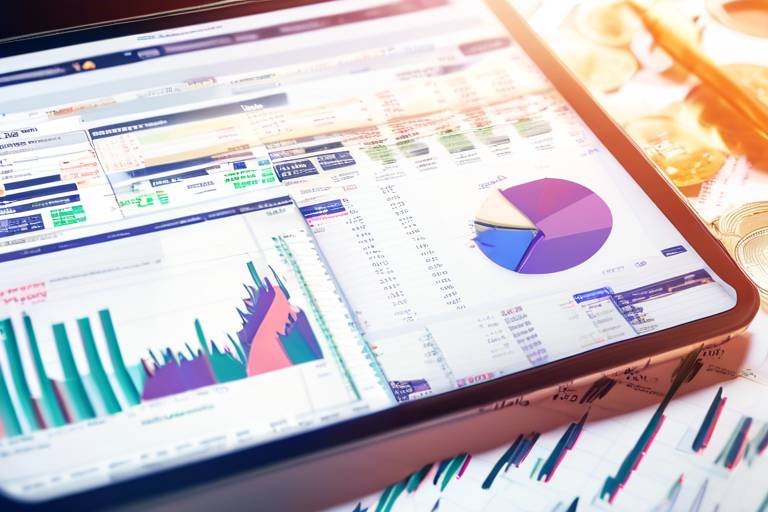How to Manage Your Trading Capital Effectively
Managing your trading capital effectively is like steering a ship through turbulent waters; it requires knowledge, skill, and a solid plan. In the world of trading, your capital is your lifeblood, and how you manage it can determine your success or failure in the financial markets. Whether you're a seasoned trader or just starting out, understanding the intricacies of trading capital is essential. This article explores various strategies and techniques that can help you ensure profitability, minimize risks, and achieve long-term success.
So, what exactly is trading capital? In simple terms, trading capital refers to the funds you have available for trading activities. It’s the pool of money that you draw from to buy and sell assets in the market. Understanding its components and importance is crucial for effective trading management and decision-making. Without a clear grasp of your trading capital, you might find yourself lost at sea, making impulsive decisions that could lead to significant losses.
Establishing a trading budget is akin to creating a roadmap for your trading journey. It helps you allocate your resources wisely, ensuring that you don’t overspend or risk more than you can afford to lose. To determine an appropriate budget, consider your individual financial situation and trading goals. Ask yourself questions like: How much can I afford to invest without jeopardizing my financial stability? What are my short-term and long-term trading objectives?
Once you have a clear understanding of your financial landscape, you can set a budget that aligns with your goals. This budget should include not just the capital you plan to trade with, but also any additional funds you may need for unexpected expenses or losses.
Risk tolerance varies among traders, much like personal preferences in food or music. Some traders are thrill-seekers, willing to take on high risks for the chance of high rewards, while others prefer a more conservative approach. Assessing your personal risk tolerance is essential for aligning your trading strategies with your comfort level.
To assess your risk tolerance, consider the following factors:
- Your financial situation: How much can you afford to lose?
- Your trading experience: Are you a novice or a seasoned trader?
- Your emotional resilience: Can you handle the stress of potential losses?
By answering these questions, you can better align your trading strategies with your risk tolerance, leading to more effective capital management.
Defining clear risk parameters is essential for effective trading. Think of it as setting up guardrails on a winding road; they keep you safe and on track. This involves setting limits on both losses and gains to protect your trading capital. For instance, you might decide that you will not risk more than 2% of your capital on a single trade. This way, even if a trade goes south, your overall capital remains intact.
Stop-loss orders are a vital tool in risk management. Implementing these orders can safeguard your trading capital from significant losses. A stop-loss order automatically sells your asset when it reaches a certain price, preventing further losses. It’s like having a safety net; you hope you never need it, but it’s reassuring to know it’s there.
To effectively use stop-loss orders, consider the following tips:
- Set your stop-loss at a level that makes sense based on your trading strategy.
- Avoid moving your stop-loss further away to give a losing trade “more room.”
- Regularly review and adjust your stop-loss levels as market conditions change.
Diversification is a strategy that helps mitigate risk by spreading investments across various assets. Imagine you’re at a buffet; if you only fill your plate with one dish and it turns out to be bad, you’re in trouble. However, if you sample a variety of dishes, you’re more likely to enjoy your meal. Similarly, diversifying your portfolio can protect your trading capital from the volatility of any single asset.
When considering diversification, think about including a mix of:
- Stocks
- Bonds
- Commodities
- Forex
This way, if one sector performs poorly, others may compensate, keeping your overall capital more stable.
Regularly monitoring and reviewing your trading performance is key to effective capital management. It’s like checking the oil in your car; if you neglect it, your engine might seize up. By analyzing your trades and adjusting your strategies accordingly, you can identify what works and what doesn’t, allowing you to refine your approach over time.
Keeping a trading journal can significantly enhance your performance. Documenting your trades, including the rationale behind each decision, helps you reflect on outcomes and learn from both successes and failures. A journal acts as a mirror, reflecting your trading habits and helping you identify patterns that may need adjustment.
Market conditions are constantly changing, much like the weather. What works today might not work tomorrow. Therefore, it’s crucial to adapt your trading strategies to current market trends to protect and grow your trading capital. Stay informed about economic indicators, news events, and other factors that can influence market movements.
Q: What is the most important aspect of managing trading capital?
A: The most important aspect is understanding your risk tolerance and setting appropriate risk parameters to protect your capital.
Q: How often should I review my trading performance?
A: It’s advisable to review your trading performance regularly, at least once a month, to identify trends and areas for improvement.
Q: Is diversification necessary in trading?
A: Yes, diversification helps mitigate risk and can protect your capital from the volatility of individual assets.

Understanding Trading Capital
Trading capital is the lifeblood of any trader's journey in the financial markets. It's not just about having money to invest; it encompasses the strategic allocation of funds that can significantly influence your trading success. Imagine your trading capital as the fuel for a car: without it, you won't get far, but how you use it can determine whether you reach your destination smoothly or run into trouble along the way.
At its core, trading capital refers to the funds available to you for trading activities, which can include stocks, forex, commodities, or cryptocurrencies. Understanding its components is crucial for effective trading management and decision-making. You need to consider not only the amount of capital you have but also how you plan to utilize it in the ever-changing landscape of the market. This involves a deep dive into the various elements that make up your trading capital, such as:
- Initial Investment: The starting amount you allocate for trading.
- Available Margin: Funds that can be used for margin trading, which allows you to leverage your positions.
- Cash Reserves: Money set aside for unexpected expenses or opportunities.
Understanding these components helps you create a robust trading plan that aligns with your financial goals. It's essential to recognize that trading capital isn't just a number; it's a reflection of your financial health and your approach to risk management. Every trader must assess their financial situation holistically, taking into account not just the capital they wish to invest, but also their overall financial obligations and future goals.
Moreover, the importance of trading capital extends beyond merely having funds available. It influences your risk appetite, your ability to withstand market downturns, and your overall trading strategy. For instance, if you have a larger trading capital, you might be more inclined to take on higher risks, potentially leading to greater rewards. However, this could also mean facing larger losses if trades don't go as planned. On the flip side, a smaller trading capital may encourage a more cautious approach, focusing on preserving capital over aggressive trading.
In summary, understanding trading capital is a multifaceted endeavor that requires careful consideration of your financial landscape and trading objectives. By grasping the intricacies of your trading capital, you can make informed decisions that enhance your profitability and minimize risks. This foundational knowledge sets the stage for effective capital management, allowing you to navigate the complexities of the financial markets with confidence.
Establishing a trading budget helps traders allocate their resources wisely. This section discusses how to determine an appropriate budget based on individual financial situations and trading goals.
Risk tolerance varies among traders. This subheading explores how to assess personal risk tolerance levels and align them with trading strategies for better capital management.
Defining clear risk parameters is essential for effective trading. This section outlines how to set limits on losses and gains to protect trading capital.
Stop-loss orders are a vital tool in risk management. Here, we discuss how to implement stop-loss orders to safeguard trading capital from significant losses.
Diversification helps mitigate risk by spreading investments across various assets. This subheading explains the importance of portfolio diversification in capital management.
Regularly monitoring and reviewing trading performance is key to effective capital management. This section covers how to analyze trades and adjust strategies accordingly.
Keeping a trading journal can enhance performance. This subheading discusses the benefits of documenting trades and reflecting on outcomes for future improvements.
Market conditions are constantly changing. This section highlights the importance of adapting trading strategies to current market trends to protect and grow trading capital.
What is trading capital?
Trading capital refers to the funds that a trader has available for trading activities in the financial markets. It is essential for executing trades and managing risks.
How much trading capital do I need to start?
The amount of trading capital you need depends on your trading strategy, risk tolerance, and the markets you wish to trade. It's important to start with an amount you can afford to lose.
Why is risk management important in trading?
Risk management is crucial because it helps protect your trading capital from significant losses and ensures that you can continue trading in the long run.
What are stop-loss orders?
Stop-loss orders are predefined price levels set to automatically close a trade to limit potential losses. They are essential for managing risk effectively.

Setting a Trading Budget
Establishing a trading budget is like creating a roadmap for your financial journey in the markets. It helps you allocate your resources wisely, ensuring that you are not just throwing your hard-earned money into trades without a clear strategy. Think of your trading budget as the foundation of your trading house; without a solid base, everything else can come crashing down. So, how do you determine an appropriate budget based on your individual financial situation and trading goals? Let's dive in!
First, it's essential to assess your overall financial health. This means taking a good look at your income, expenses, savings, and any debts you might have. You wouldn't want to risk money that you can't afford to lose, right? Aim to set aside a specific amount that you can dedicate solely to trading—this should be money that, if lost, won't affect your daily life or financial stability. A good rule of thumb is to allocate only a small percentage of your total net worth—typically between 1% to 5%—for trading activities.
Next, consider your trading goals. Are you looking to make quick profits, or are you in it for the long haul? Your objectives will influence how much capital you should commit. If you're a day trader looking for rapid gains, you might need a larger budget compared to a swing trader who holds positions for days or weeks. It's crucial to align your budget with your trading style. For example, if you're targeting a 10% return on a $5,000 budget, that’s a much different game plan than if you're working with $50,000.
Once you have a clear understanding of your financial situation and goals, it’s time to set your trading budget. Here’s a simple formula to help you get started:
| Parameter | Suggested Amount |
|---|---|
| Total Net Worth | $100,000 |
| Trading Capital (1% of Net Worth) | $1,000 |
| Trading Capital (5% of Net Worth) | $5,000 |
With your budget set, it’s vital to stick to it. This is where discipline comes into play. Just like a diet, if you stray from your budget, you might find yourself in a world of trouble. Be prepared to adjust your budget based on market conditions and your trading performance, but always ensure that adjustments are made thoughtfully and not impulsively.
Lastly, remember to review your budget regularly. Life changes, and so do market conditions. By keeping a close eye on your budget, you can make informed decisions about whether to increase or decrease your trading capital. This ongoing review process not only helps in effective capital management but also enhances your overall trading strategy. So, are you ready to set that budget and take control of your trading journey?

Assessing Risk Tolerance
When it comes to trading, understanding your risk tolerance is like knowing your limits before diving into a pool. You wouldn’t jump into the deep end if you can’t swim, right? Similarly, assessing your risk tolerance helps you navigate the financial waters without getting in over your head. Risk tolerance refers to the degree of variability in investment returns that an individual is willing to withstand in their trading activities. It’s crucial to pinpoint this because it shapes your trading strategy and ultimately influences your capital management.
To effectively assess your risk tolerance, consider a few key factors that play a significant role:
- Financial Situation: Your current financial standing can greatly influence how much risk you can afford to take. If you have a stable income and savings, you might be more inclined to take on higher risks.
- Investment Goals: Are you looking to grow your wealth over the long term, or do you want quick gains? Your goals will dictate your risk appetite.
- Experience Level: New traders might prefer to play it safe, while seasoned traders may be more comfortable with risky trades based on their past experiences.
Once you’ve considered these factors, it’s time to evaluate your psychological comfort with risk. This is where self-reflection comes into play. Ask yourself questions like:
- How do I react to market fluctuations?
- Am I able to sleep at night when my investments dip?
- Can I handle the emotional rollercoaster that comes with trading?
Understanding your emotional response to risk is just as important as the numbers. For instance, if you find that you’re constantly anxious when the market is volatile, you might want to adopt a more conservative trading approach. On the flip side, if you thrive on the excitement of high-stakes trading, you may be more suited for aggressive strategies.
Another effective method to gauge your risk tolerance is through the use of risk assessment questionnaires. These tools often consist of a series of questions designed to evaluate your financial situation, investment goals, and emotional comfort with risk. Based on your answers, you can get a clearer picture of whether you’re a conservative, moderate, or aggressive trader.
Ultimately, assessing your risk tolerance is not a one-time task. As your financial situation, market conditions, and personal circumstances change, it’s essential to revisit your risk assessment regularly. Think of it as a health check-up for your trading strategy—keeping your approach aligned with your current situation will help you manage your trading capital more effectively and ensure you are on the path to long-term success.
Q: What is risk tolerance?
A: Risk tolerance is the degree of variability in investment returns that an individual is willing to withstand. It helps in shaping trading strategies and capital management.
Q: How can I assess my risk tolerance?
A: You can assess your risk tolerance by evaluating your financial situation, investment goals, experience level, and emotional responses to market fluctuations.
Q: Is risk tolerance static?
A: No, risk tolerance can change over time due to shifts in financial circumstances, market conditions, and personal experiences, so it’s important to reassess regularly.

Defining Risk Parameters
When it comes to trading, defining your risk parameters is like drawing a line in the sand. It’s essential to know how much risk you’re willing to take before you dive into the turbulent waters of the financial markets. Think of it as setting the rules of engagement; without them, you might find yourself in a precarious situation, potentially losing more than you can afford.
To effectively define your risk parameters, start by evaluating your overall financial situation. How much capital do you have available for trading? This isn’t just about the funds you’re willing to invest; it’s about understanding your financial landscape, including your savings, expenses, and any other investments. A good rule of thumb is to only risk a small percentage of your trading capital on a single trade—many experts recommend between 1% to 3% of your total trading capital. This approach helps ensure that a few bad trades won’t wipe you out completely.
Next, you should consider your trading strategy. Are you a day trader looking for quick gains, or are you more of a long-term investor? Different strategies come with different levels of risk. For instance, day trading might require tighter stop-loss orders due to the rapid fluctuations in price, while long-term investing might allow for a more relaxed approach. Understanding the nuances of your strategy will help you set realistic and effective risk parameters.
Once you have a grasp on your financial situation and trading strategy, it’s time to set specific limits. These limits can be categorized into two main types: loss limits and gain limits. Loss limits help you determine when to exit a trade to prevent deeper losses, while gain limits allow you to lock in profits before the market turns against you. For example, if you set a loss limit at 2% of your capital on a particular trade, you’ll exit the position as soon as your losses reach that threshold. Conversely, if you set a gain limit at 5%, you’ll take your profits once the trade hits that mark.
To further illustrate this concept, consider the following table that outlines a simple risk management framework:
| Parameter | Example Setting |
|---|---|
| Risk per Trade | 2% of total capital |
| Loss Limit | Exit if loss reaches 2% |
| Gain Limit | Take profit at 5% |
| Maximum Drawdown | No more than 10% of total capital |
It’s also crucial to revisit and adjust your risk parameters regularly. As you gain experience and your trading capital grows or shrinks, your risk tolerance may change. Keeping an eye on your performance and adjusting your parameters accordingly can help you stay aligned with your trading goals.
In summary, defining your risk parameters is a fundamental step in managing your trading capital effectively. By understanding your finances, setting specific loss and gain limits, and regularly reviewing your strategy, you can navigate the markets with greater confidence and security. Remember, trading isn’t just about making money; it’s also about protecting what you have. So, take the time to define your risk parameters, and you’ll be well on your way to achieving long-term success!
- What are risk parameters in trading? Risk parameters are the specific limits you set regarding how much capital you’re willing to risk on a trade, including loss and gain thresholds.
- How do I determine my risk tolerance? Assess your financial situation, consider your trading strategy, and reflect on how much loss you can comfortably absorb without affecting your lifestyle.
- Why are stop-loss orders important? Stop-loss orders help protect your trading capital by automatically selling a position once it reaches a pre-defined loss limit, preventing larger losses.
- How often should I review my risk parameters? Regular reviews are essential, especially after significant market changes or personal financial shifts. Aim to review your parameters at least quarterly.

Using Stop-Loss Orders
When it comes to trading, one of the most effective ways to protect your capital is by using stop-loss orders. Imagine you're sailing on a vast ocean of financial opportunities, but there are storms lurking beneath the surface. A stop-loss order acts like your safety net, ensuring that if the waves get too rough, you don’t go down with the ship. But what exactly is a stop-loss order, and how can it help you manage your trading capital more effectively?
A stop-loss order is a predetermined price at which you instruct your broker to sell a security to prevent further losses. Think of it as a protective barrier that activates when the market moves against your position. For instance, if you buy a stock at $50 and set a stop-loss order at $45, you’re essentially saying, “If this stock drops to $45, sell it!” This strategy not only helps you limit losses but also takes the emotional element out of trading. When emotions run high, traders often make rash decisions. A stop-loss order removes that pressure, allowing you to stick to your trading plan.
Now, you might be wondering, “How do I set an effective stop-loss order?” The answer lies in understanding your trading strategy and risk tolerance. Here are some factors to consider:
- Market Volatility: If you’re trading in a highly volatile market, setting a tighter stop-loss might lead to premature sell-offs. Conversely, in a stable market, a tighter stop-loss can protect your capital more effectively.
- Support and Resistance Levels: Analyzing historical price levels can help you determine where to place your stop-loss. Setting it just below a support level can be a strategic move, as prices often bounce back from these points.
- Percentage of Capital: Many traders choose to risk a small percentage of their capital on any single trade, often around 1-2%. This means if your stop-loss is triggered, you’re only losing a fraction of your total trading capital.
Implementing stop-loss orders is not just about setting them and forgetting them. It’s crucial to regularly review and adjust them based on market conditions. For instance, if your stock price rises significantly, consider moving your stop-loss order up to lock in profits while still protecting against potential downturns. This practice, known as a trailing stop-loss, allows you to maximize your gains while minimizing risks.
In conclusion, using stop-loss orders is an essential strategy for any trader looking to manage their capital effectively. It’s like having a life jacket while navigating turbulent waters; it won’t prevent you from encountering storms, but it will keep you afloat when things get rough. So, as you embark on your trading journey, remember to incorporate stop-loss orders into your strategy and watch your capital management skills soar.
1. What is a stop-loss order?
A stop-loss order is an instruction to sell a security when it reaches a certain price, helping to limit potential losses.
2. How do I determine where to set my stop-loss?
Consider factors like market volatility, support and resistance levels, and your overall risk tolerance when setting your stop-loss.
3. Can I adjust my stop-loss order after setting it?
Yes, you can and should adjust your stop-loss order based on market conditions and your trading strategy.
4. What is a trailing stop-loss?
A trailing stop-loss is a dynamic order that moves with the market price, allowing you to lock in profits while still protecting against losses.

Diversifying Your Portfolio
Diversification is like a safety net for your investments; it helps to cushion the blows when the market gets a little bumpy. Imagine you have a basket of eggs. If you put all your eggs in one basket and that basket falls, you're left with a mess. But if you spread those eggs across several baskets, even if one falls, you still have others intact. This analogy perfectly illustrates why portfolio diversification is crucial in trading. By spreading your investments across various asset classes—such as stocks, bonds, commodities, and real estate—you can significantly reduce the risk associated with market volatility.
When you diversify your portfolio, you're not only protecting your capital but also enhancing your potential for returns. Different assets often react differently to market conditions. For instance, when stock prices are plummeting, bonds might be holding steady or even rising, providing a buffer against losses. This is why a well-diversified portfolio can be a trader’s best friend, allowing for more stable growth over time.
So, how do you go about diversifying? Start by evaluating your current investments. Take a look at what you own and ask yourself if you’re overly concentrated in one area. If you find that you have a lot of tech stocks, consider branching out into sectors like healthcare or consumer goods. Here’s a basic breakdown of how you might think about allocating your investments:
| Asset Class | Percentage Allocation |
|---|---|
| Stocks | 40% |
| Bonds | 30% |
| Real Estate | 20% |
| Commodities | 10% |
This table is just a starting point and can be adjusted based on your individual risk tolerance and investment goals. The key is to find a balance that works for you. Remember, diversification is not about eliminating risk entirely; it’s about managing it effectively. The more you spread your investments, the less likely you are to suffer catastrophic losses from a single market event.
Additionally, don’t forget to regularly review your portfolio. Market conditions change, and what was once a balanced portfolio may become skewed over time. Rebalancing your investments periodically ensures that you maintain your desired level of risk and return. It’s like a garden; you need to prune and adjust as it grows to keep it healthy and thriving.
In conclusion, is not just a smart strategy; it’s an essential practice for anyone serious about trading. By spreading your investments across different asset classes, you can protect your capital from unexpected market shifts and position yourself for long-term success. So, take a moment to evaluate your investments today—your future self will thank you!
- What is diversification in trading? Diversification in trading refers to the practice of spreading investments across various asset classes to reduce risk.
- Why is diversification important? It helps mitigate the impact of poor performance in any single investment, leading to more stable overall returns.
- How often should I rebalance my portfolio? It’s advisable to review and rebalance your portfolio at least once a year or whenever there are significant changes in your financial situation or market conditions.
- Can I diversify with just a few investments? While it's possible, having a broader range of investments typically provides better risk management.

Monitoring and Reviewing Performance
Monitoring and reviewing your trading performance is like keeping a pulse on your financial health. It’s not just about making trades; it’s about understanding how those trades are affecting your overall capital. By regularly analyzing your performance, you can identify patterns, recognize what strategies are working, and pinpoint areas that need improvement. This process is crucial for effective capital management, as it allows you to adjust your approach based on real data rather than gut feelings.
Think of your trading performance as a road trip. You wouldn’t drive for hours without checking your map or GPS, would you? Similarly, in trading, you need to regularly check your progress towards your financial goals. This involves looking at your win-loss ratio, average return on investment, and the overall growth of your trading capital. By keeping an eye on these metrics, you can ensure that you’re on the right track.
To make this process easier, consider utilizing a trading journal. A trading journal is like a diary for your trades, where you can document every decision you make. This includes the reasons behind your trades, the outcomes, and any emotional factors that may have influenced your decisions. Over time, this documentation will provide invaluable insights into your trading behavior. You’ll start to see trends that can help you refine your strategies. For example, if you notice that you consistently perform better during specific market conditions, you can adjust your trading plan accordingly.
Here are a few key elements to consider when monitoring your trading performance:
- Win-Loss Ratio: This is the percentage of trades that were profitable compared to those that were not. A higher ratio indicates better performance.
- Average Gain vs. Average Loss: Understanding how much you typically gain on winning trades versus how much you lose on losing trades can help you fine-tune your strategies.
- Risk-Reward Ratio: This ratio helps you measure the potential reward of a trade against the risk you’re taking. A favorable ratio can lead to long-term success.
After gathering this data, it’s essential to review it regularly—weekly, monthly, or quarterly, depending on your trading style. During these reviews, ask yourself some critical questions:
- What strategies have been most effective?
- Are there any recurring mistakes I need to address?
- How do my emotional responses affect my trading decisions?
By answering these questions, you’ll be able to adapt your trading strategies to better align with your goals and market conditions. Remember, the market is always changing, and your strategies should be flexible enough to adapt to those changes. If you find that a particular strategy isn’t working, don’t be afraid to pivot. It’s all part of the learning process.
In conclusion, monitoring and reviewing your trading performance is not just a chore; it’s an opportunity for growth and improvement. By keeping a close eye on your trades and reflecting on your decisions, you’ll be better equipped to manage your trading capital effectively and increase your chances of long-term success.
- Why is monitoring trading performance important? It allows traders to identify successful strategies, recognize areas for improvement, and adjust their approaches accordingly.
- How often should I review my trading performance? Regular reviews are recommended, such as weekly or monthly, depending on your trading style.
- What should I include in my trading journal? Document your trades, the reasons behind your decisions, outcomes, and any emotional factors that influenced your trades.

Utilizing Trading Journals
Trading journals are often overlooked but are a powerful tool for any trader looking to enhance their performance and manage their capital effectively. Think of a trading journal as your personal roadmap; it not only tracks where you've been but also helps you navigate where you're going. By documenting your trades, you create a comprehensive record that allows you to analyze your decisions, understand your strengths and weaknesses, and ultimately improve your trading strategies.
So, what exactly should you include in your trading journal? Here are some key elements to consider:
- Date and Time: Note when each trade was executed. This helps you identify patterns related to specific market conditions.
- Asset Traded: Specify which asset you traded—this could be stocks, forex, commodities, etc.
- Entry and Exit Points: Record the price at which you entered and exited the trade. This is crucial for analyzing your performance.
- Trade Size: Document how much capital was allocated to each trade. This helps you understand your risk exposure.
- Rationale for Trade: Write down why you decided to make the trade. What were your thoughts and market analysis at the time?
- Outcome: Note whether the trade was profitable or not, and by how much. This will help you evaluate your trading strategies over time.
- Emotional State: Reflect on your emotions during the trade. Were you anxious, confident, or second-guessing yourself? Understanding your emotional responses can improve your decision-making process in the future.
By maintaining a detailed trading journal, you can identify trends in your trading behavior. For instance, you might notice that you consistently perform better when trading certain assets or during specific market conditions. This kind of insight can help you refine your strategies and focus your efforts on what works best for you.
Moreover, reviewing your journal regularly can serve as a valuable learning experience. It allows you to revisit your past trades and learn from both your successes and mistakes. Just like a sports team analyzes their game footage to improve performance, you can use your trading journal to assess your trading strategy, make necessary adjustments, and ultimately enhance your overall trading skill set.
In conclusion, utilizing a trading journal is not just about keeping track of your trades; it's about creating a feedback loop that fosters continuous improvement. By documenting your trading activities and reflecting on them, you can develop a deeper understanding of your trading style and make informed decisions that protect and grow your trading capital.
Q1: How often should I update my trading journal?
A1: It’s best to update your trading journal after every trade. This ensures that your insights are fresh and accurately reflect your thought process at the time of the trade.
Q2: Can I use digital tools to maintain my trading journal?
A2: Absolutely! Many traders use spreadsheet software or specialized trading journal apps that allow for easier tracking and analysis of trades.
Q3: What if I forget to document a trade?
A3: While it's ideal to document every trade, don't stress too much if you miss one. Just make it a habit to start recording your trades consistently moving forward.
Q4: Will maintaining a trading journal really improve my trading?
A4: Yes! A trading journal can provide you with insights into your trading behavior, helping you make more informed decisions and avoid repeating past mistakes.

Adapting to Market Conditions
In the ever-changing landscape of financial markets, is not just a strategy; it's a necessity. Imagine trying to sail a boat in unpredictable weather without adjusting your sails. You wouldn’t get very far, would you? Similarly, traders must be agile, ready to modify their strategies in response to market fluctuations. This adaptability can be the difference between thriving and merely surviving in the trading world.
The first step in adapting to market conditions is to stay informed. Regularly following financial news and market analysis can provide insights into trends that might affect your trading strategy. For instance, economic indicators such as unemployment rates, inflation data, and central bank announcements can significantly influence market sentiment. By being aware of these factors, traders can make informed decisions that align with current market dynamics.
Next, consider implementing a flexible trading plan. A rigid plan might work in a stable market, but when volatility strikes, it’s essential to have a plan that allows for adjustments. This could mean being open to changing your entry and exit points based on real-time market analysis. For example, if you notice a sudden surge in volatility, you might want to tighten your stop-loss orders or consider scaling back on new positions.
Moreover, utilizing technical analysis tools can help you identify patterns and trends that signal when to adapt your strategy. For instance, if you observe a consistent downtrend in a particular asset, it might be wise to either short the asset or avoid it altogether until conditions improve. On the other hand, if you notice a bullish trend, you might want to increase your exposure to that asset. The key is to remain vigilant and responsive.
Another important aspect is to regularly review your performance and strategies. This doesn’t just mean looking at your profits and losses; it involves analyzing what worked, what didn’t, and why. By keeping a trading journal, you can document your trades, thoughts, and the market conditions at the time. This reflection can provide valuable insights and help you adapt your strategies for future trades.
Lastly, don't forget the emotional aspect of trading. Market conditions can evoke strong feelings—fear during downturns and greed during uptrends. Developing emotional resilience is crucial. It’s easy to let emotions dictate your trading decisions, but staying calm and collected will allow you to make rational choices based on your analysis rather than impulsive reactions.
In summary, adapting to market conditions requires a combination of staying informed, being flexible, utilizing analytical tools, regularly reviewing performance, and managing emotions. By embracing these strategies, traders can not only protect their capital but also position themselves for long-term success in the financial markets.
- What is the best way to stay informed about market conditions? Regularly follow financial news, subscribe to market analysis newsletters, and utilize financial platforms that provide real-time data.
- How often should I review my trading strategies? It’s advisable to review your strategies after every major trade and at least once a month to assess overall performance.
- Can emotional management really impact trading success? Absolutely! Emotional decisions can lead to significant losses. Developing emotional resilience helps maintain discipline in trading.
- What tools can help with technical analysis? Many platforms offer charting tools, indicators, and automated trading systems that can assist in technical analysis.
Frequently Asked Questions
- What is trading capital?
Trading capital refers to the funds that a trader has available to engage in trading activities. It's crucial to understand that this capital is not just about the money you have; it's about how you manage and allocate these funds to maximize your trading potential.
- How do I set a trading budget?
Setting a trading budget involves evaluating your financial situation, understanding your trading goals, and determining how much money you can afford to risk. It's like planning a road trip; you need to know how much gas you can buy before hitting the road!
- What is risk tolerance, and why is it important?
Risk tolerance is your ability and willingness to endure losses in your trading activities. It varies from person to person, and understanding your own risk tolerance is essential for aligning your trading strategies with your comfort level. Think of it as knowing how much spice you can handle in your food!
- How can I define my risk parameters?
Defining risk parameters involves setting clear limits on how much you are willing to lose on a trade and how much profit you aim to achieve. This is important because it helps protect your trading capital and ensures that you don’t get carried away in the heat of the moment.
- What are stop-loss orders, and how do they work?
Stop-loss orders are instructions to sell a security when it reaches a certain price, helping to minimize potential losses. They act like a safety net, catching you before you fall too far if the market moves against you!
- Why is portfolio diversification important?
Diversifying your portfolio means spreading your investments across various assets to mitigate risk. It’s like not putting all your eggs in one basket; if one asset underperforms, others may perform well, balancing out your overall performance.
- How often should I monitor my trading performance?
Regularly monitoring your trading performance is key to effective capital management. It’s recommended to review your trades at least weekly, reflecting on what worked and what didn’t, much like checking the scoreboard during a game!
- What is the benefit of keeping a trading journal?
A trading journal helps you document your trades, analyze your decision-making process, and reflect on outcomes. This practice can enhance your performance over time, helping you learn from both your successes and mistakes.
- How can I adapt to changing market conditions?
Adapting to market conditions involves staying informed about market trends and being flexible with your trading strategies. Just like a surfer adjusts their stance based on the waves, you need to adjust your approach to ride the market's ups and downs successfully!



















